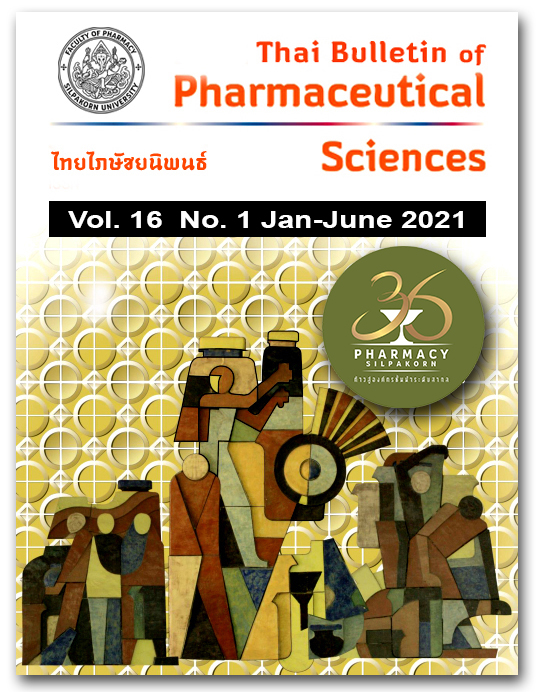DEVELOPMENT OF A COLLABORATIVE MODEL TO PROMOTE RATIONAL USE OF MEDICATION IN COMMUNITY BY PUBLIC PARTICIPATION IN MAHASARAKHAM URBAN COMMUNITY
DOI:
https://doi.org/10.69598/tbps.16.1.123-139Keywords:
drug safety in community, develop model participation, public participation, surveillance of dangerous drug distributionAbstract
Several dangerous drugs (antibiotics, steroids, NSAIDs) have been distributed in urban community health systems of Mahasarakham Province which causes people to use medication inappropriately. This study aimed to develop a collaborative model to promote rational use of medication in communities by public participation. This study used a participatory action research approach; composed of four steps including: planning the collaborative model; implementation of the model; observation and monitor impacts of the model; and feedback and summarized effectiveness of the model. The target sample was 816 grocery stores located in urban communities, 211 relevant stakeholders and 140 households of chronic disease patients. This study was conducted during October 2017 – December 2018. Two measures were commonly agreed to control dangerous drug distribution. The measures were focused in two risky sectors: grocery stores and drug delivery by vehicles. After implementing the collaborative model, dangerous drug distribution was observed less frequently, from 98.04% to 19.39% (p=0.0001). Risky health products containing steroids found in households of chronic disease patients decreased from 15.00% to 5.71% (p=0.0001). The potential development of the target groups on rational drug use resulted in a statistically significantly (p=0.0001) higher knowledge score. This collaborative model to promote drug safety was named “MEDGEM2MHKA Model” which led to the success of building a drug safety system in the community. This study showed not only successful results but also reflected earnestness from all participated stakeholders involved in community health care.
References
Health administration division. Service plan: Rational drug use. n.p. 2016. (in Thai)
Health administration division. Rational drug use community: RDU community. n.p. 2020. (in Thai)
Rajatanavin R, Suksiriwong C, Pongcharoensuk P, Chailuekij L, Takkinsatien A. Pevalence of overt manifestation of steroid abuse without medical indication. Bangkok: National research council of Thailand Press; 2007. Contract No.: 02190288. Sponsored by National research council of Thailand. (in Thai)
Sirivitayakul P. (2018). Physiology of adrenal gland. Bangkod Retrieved from http://biochem.md.chula.ac.th/Data/ Endocrine. (in Thai)
Food and drug administration. Collect data’s guide for rational drug use community. n.p. 2016. (in Thai)
Strategy and planning division. The sub-district health promoting hospital Tid Dao’s guide for development. n.p. 2016. (in Thai)
Bloom BS. Handbook on formation and Summative Evaluation of Student Learning. New York: McGraw-Hill Book Company, 1971.
Surin N. Prevalence and characteristics of grocery stores that sold antibiotics in Amphoe Muangpan, Lampang province. Thai J Pharm Pract. 2015;7(2):200-5.
Sungthong W. Prevalence of grocery stores with antibiotics selling at Maesuai district, Chiang Rai province and its affecting factors. Thai J Pharm Pract. 2015;7(1):38-46.
Ruenruay S. Situation of medicines and dietary supplements in the health provider board region 3. Thai J Pharm Pract. 2017;9(1):225-35.
Kanjanarach T. Health care of a community to manage medicine and health product. Khon Kaen: Khon Kaen University printing; 2017.
Pattamasaravut P. Development of model grocery stores from the civil state project on collective action for drugs safety in communities. Thai J Pharm Pract. 2020;12(3):601-11.
Chompoo A, Surin S. Dangerous drugs distribution surveillance in grocery stores of consumer protection group in the area of Mae Sa Riang hospital. FDA Journal. 2015;22(1):45-50.
Pumtong S. Final report’ s a project to rational drug use in community. The annual fiscal year 2018-2019. Nonthaburi: Food and drug administration. 2019. Sponsored by the Food and drug administration. (in Thai)
Angkanavisul T. Lessons learned from the project on drug safety management within community by engaging the network of partners in Phra Nakhon Si Ayutthaya during 2015-2017. Thai J Pharm Pract. 2016;8(2):143-60.
Nata P. Integrating pharmacist’s roles in health consumer protection into community health system. Thai J Pharm Pract .2019;11(1):61-75.
Thai health consumer [Internet]. Bangkok: Health consumer protection; 2015. [cited 2021 Jan 27]. Available from: http://www.thaihealthconsumer.org/images/mydata/ doc/law/HealthPro/2007-NationalHealthAct.pdf (in Thai)
Downloads
Published
How to Cite
Issue
Section
License
All articles published and information contained in this journal such as text, graphics, logos and images is copyrighted by and proprietary to the Thai Bulletin of Pharmaceutical Sciences, and may not be reproduced in whole or in part by persons, organizations, or corporations other than the Thai Bulletin of Pharmaceutical Sciences and the authors without prior written permission.



